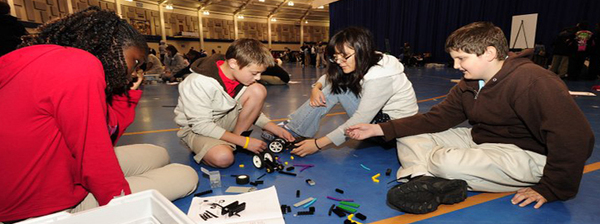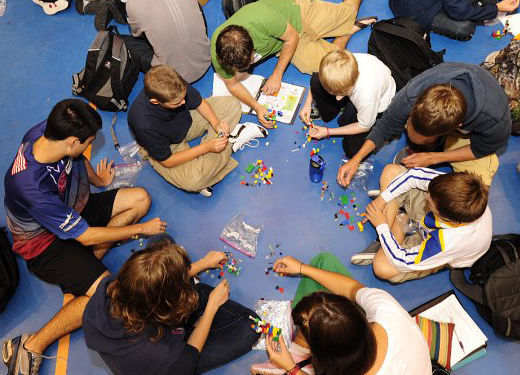“Not a volcano in sight,” says Jay Brockman, associate dean and associate professor of electrical engineering at Notre Dame. Brockman was watching hundreds of fifth graders fully engaged in two active projects to help them learn about the kinds of questions that engineers and scientists ask and answer: why do things work the way they do and how can we make them work better? His response was to the students’ principals, who had seen far too many science fair volcanoes in their careers.

On Friday, September 9, more than 300 fifth graders from the South Bend Community School Corporation (SBCSC) worked with 450 Notre Dame engineering undergraduates as part of a technology discovery day: I2D2 – Imagination, Innovation, Discovery and Design at the Joyce Center on Notre Dame’s campus.
In its second year, planners of the event purposefully do not label the activities as explicitly “science” or “engineering”. The idea is to introduce local fifth graders to the wonders of discovery and to expose children and their parents to new ways of thinking.
Jeremy Williams, father of Jazlyn, a fifth grader at Edison, says “I’ve enjoyed observing kids today in their own world…[hearing] the reasoning behind their answers. My daughter knows I’m an ND fan. She was excited to share this experience with me… [It] takes me back; it feels good to be a kid!”
A Jefferson parent, Tracilyn Chase imagines that for ND students, being with young children is a delight. “Here in the community, we hear a lot about ND," she says. "To actually be here in an academic setting with Notre Dame Students, our children see what they could be doing [in the future].”
On the flipside, Notre Dame first-year engineering students get hands-on experience, tasked with designing robot pets that would be appealing to 10-year-old children.
The ND engineering students learn not only about sensors and technology, but also how to interview a customer—in this case a fifth grader—and to incorporate feedback to improve their designs. Balancing what they can do with what the customer wants is a skill that will be important as they advance in their careers as engineers. Victoria Goodrich, co-director of the first-year engineering program, explains, “As engineers it is important that we make things that customers are going to use!”
Genaro Andazola, a first-year Notre Dame student from Juarez, Mexico, described the experience of receiving feedback from his young clients: “I showed my work to peers and teachers in high school in order to improve it, but never like this. This is a lot more fun! Kids provide a fresh perspective and a new way of looking at things.”
Andazola looks forward to the next six weeks, when he and other ND students will design and build pets using LEGO Mindstorms NXT systems. They'll demonstrate their projects at the intermediate center, where they'll be judged by their fifth-grade clients.
Jay Brockman, explains that his colleagues at Tufts University and Olin College in Massachusetts had been working with elementary age children and robotics. Brockman thought it sounded like an interesting idea. At first, he planned to pilot the idea with one fifth-grade class. However the principals at both Edison and Jefferson Schools were so receptive Brockman decided to engage the entire fifth grade classes at both institutions. “Luckily,” Brockman says, “co-directors Kerry Myers and Victoria Goodrich never shy away from a large organizational challenge! So they designed a half-day event with lots of kids and in collaboration with the principals. Everyone was on board.”
Karen Morris, of the Center for Sustainable Energy at Notre Dame, organized numerous volunteers across campus to participate in the day’s events. A solid relationship has developed between the University and many of the SBCSC principals, says Morris. “I know and interact with the principals of Edison and Jefferson frequently. They have been very generous with the use of their spaces, and with the time of their students."

The second active learning project of the day was the Domer Freewheeling Derby, where the students design and test LEGO vehicles to learn about energy and motion. Through testing their designs and collecting data, the students learn how scientists and engineers refine their ideas with experiments. Jefferson fifth grader, Tamia Chase says, “At first [the derby] was hard to figure out, but making a car didn’t feel like hard work, it was fun!”
In addition to competing in the derby and helping to design a robotic pet, the elementary students are exposed to the fields of Science, Technology, Engineering and Mathematics (STEM) educational options available to them. They have lunch on campus, are given a campus tour of the science and engineering buildings and receive their own LEGO kit.
Julie Petersen, a 30-year veteran school teacher, says, “For my students, they think of ND as the Golden Dome and football. It's important for them to meet Notre Dame Students and to work with them in an academic setting. Most of my kids live within two miles from here, but very few had ever been on campus.”
Gail Kirkland, an instructional aid at Edison, loves to see her students' eyes brighten. “You can do things with science…we just don’t know where it will take them!” she says.
Jay Brockman smiles in agreement to Kirkland’s comment about the power of science. These young Jefferson and Edison scientists are learning to ask important questions about how things work and how to make them work better. We suspect they will produce far fewer volcanoes this year at their respective science fairs.